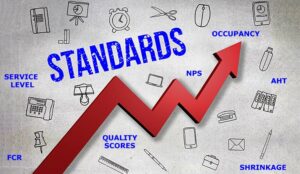Measurement in the performance of contact centre agents is changing rapidly.
Paul Weald looks at what new measures need to be implemented so that organisations not only serve the customer better but also inspire loyalty and advocacy.
A forward-thinking perspective
Since call centres were first invented, much has been written about the need to focus on efficiency measures, such as call duration, alongside effectiveness measures such as conversion rate and first-time fix. However, after the 2009 recession, a new perspective is now emerging – one that balances customer need, agent well-being and the wider organisational objectives.
To arrive at a consensus on the twelve call centre metrics that you cannot live without, let’s first look at each of these areas:
Customer Experience
Customer experience relates to the journey that a user takes from first awareness in an organisation’s purchasing process, then the delivery of services, through to becoming a repeat customer. Increasingly this experience is multi-channel – involving contact online, through the telephone, written communication and potentially social media.
Customer experience can be measured by obtaining customer feedback at every stage of the customer’s journey. For the contact centre this could mean some combination of:
- Mystery shopping
- Implementing post-call surveys
- Adopting customer advocacy – where the primary performance indicator is a measure that tests whether the customer would recommend the organisation to friends and family.
As organisations adopt these direct feedback approaches, there has been a rise in popularity of customer advocacy benchmarks that segment the customer base into Promoters, i.e. those that rank the organisation as 9 out of 10 or better; the Passives and then the Detractors, i.e. those who rate their experience at 6 out of 10 or worse. The ‘net promoter’ benchmark is then the number of ‘promoters’ less the number of ‘detractors’. This is increasingly being used as a barometer to test the end-to-end customer experience.
So a guiding principle for having the right call centre metrics is that that they should all be considered outside-in, i.e. from the customer expectation inwards. This means that the contact centre should make redundant any internal measures that do not have an effect on the customer experience, leaving the focus solely on those metrics that are driven by customer needs.
The conventional thinking about quality assessments is that they are a good thing for contact centres to focus on. The logic is simple – the attributes of a good call can be defined as a balance of functional factors allied to the right call-handling “soft” skills and then team leaders review a sample of calls across their agents to identify the overall quality of service being delivered. However, some forward-thinking organisations are now challenging this thinking and are replacing quality assessment with direct customer feedback – basically letting the customer rate the performance of the agent in that call and reporting these results in a post-call survey.
As a judge for contact centre award schemes, we now see that top performing operations use a combination of net promoter and post-call survey techniques.
British Gas Premier Energy, the European Contact Centre of the Year in 2010, is a good example. They achieve a 25 per cent post-call survey sample that then drives their understanding of where problems exist with the service that they are providing. They are now taking their thinking one stage further by focusing on customer effort. Using the experience of the Customer Contact Council, a global membership organisation, this approach is based on the research evidence that service organisations create loyal customers primarily by reducing customer effort, i.e. helping them solve their problems quickly and easily.
You can view the British Gas speaking on call centre metrics.
Agent Experience
It is a truism that you will only achieve a high level of customer satisfaction if you have employees who are engaged and motivated to achieve this outcome. This is the foundation on which every excellent contact centre is built. So having the right call centre metrics is one thing; what is also required is that the organisation has the right procedures and culture that reinforces high levels of employee engagement.
So in order to ensure employee well-being, the approach to measuring the agent experience should be based on the following principles:
- Regular feedback – at least daily reporting on performance at an agent level
- Having the right environment – where information is shared and the results are acted upon
- Changing the mindset of staff to understand “what good looks like” from a customer perspective
- Recognising the importance in the role of team leaders in supporting staff through any cultural change transformation
- Operational discipline – workforce planning tools generate detailed call forecasts that are used to roster resources – so tracking agent adherence to these schedules is key
Pulling all these performance management factors together and we are ready to define our first six KPIs for agent performance:
1. Customer feedback scores – relating to the agent’s performance and the overall customer advocacy e.g. net promoter score or customer effort score.
2. Quality scores – from call and email assessments.
3. Achievement of call outcome e.g. percentage of first-time fix in a service environment; percentage conversion rate in a selling environment.
4. Adherence to schedule – so that the planning integrity of the contact centre roster and schedule is maintained.
5. Productivity – the number of work items processed per hour together with the agent availability.
6. Lateness and sickness – so that unauthorised employee absences are tracked.
Stakeholder Experience
The third element to consider in call centre metric design is the wider stakeholder impact. The modern contact centre should not exist in a silo – instead it should be joined up to the rest of the organisation. In addition to overall customer satisfaction, the business issues that matter when considering this wider perspective are to understand the costs and value that the contact centre provides.
Consider all the factors that impact cost per contact:
- How well are the resources being used – are there large periods of the day when the contact centre is under or over resourced?
- Are the lowest-cost contact channels being exploited – do customers use online self service when the contact centre is operating at peak times and wait times inevitably increase?
- Are root causes of customer contact understood – so that avoidable contact can be minimised?
The answers to these questions often lie outside the contact centre – within other departments. For example, has Marketing reflected their promotional campaigns in the latest call forecast? Has IT updated the website with the latest information? And does Finance understand the different cost per channel that customers use?
So the contact centre can only really operate efficiently and effectively when it is joined up to the rest of the organisation. However, there is one other factor that is within the control of the contact centre manager and that is the relative performance of different teams and even different sites in a multi-location operation. The first step in managing overall contact centre performance should therefore be to aggregate the six agent KPIs on a team and centre level. Who are the best performers and what is the spread of the results?
Finally, we can add our second set of six KPIs for the organisation stakeholders:
7. Call centre churn – as an indicator of the organisational culture.
8. Spread of performance – across teams and site locations.
9. Forecast accuracy – the percentage difference between contacts actually received versus the forecast contact levels.
10. Service levels achieved – for voice, email and any online support services e.g. call answer time, email turnaround time, abandon rate, etc.
11. Cost per contact – broken down by channel.
12. Reduction in failure demand – so that continuous improvement remains a focus.
Where are you now?

Paul Weald
So how does your organisation rate against these twelve call centre metrics and where do you aspire to be in the future?
Paul Weald, Strategy Director of Customer Innovations at ProtoCall One
Author: Jonty Pearce
Published On: 12th Jan 2011 - Last modified: 2nd Nov 2017
Read more about - Customer Service Strategy, Key Performance Indicators (KPIs), Measurement, Metrics, Monitoring


















Paul,
Just a quick extension on your NPS point:
The rise of transactional Net Promoter Score use in call centres is allowing organisations to really understand the customer experience minute to minute. With that information they are able to make immediate changes to their business to improve customer loyalty.
The only issue is capturing and managing the information in a useful way.
[Part of post removed – no advertising is allowed in the comments]
Adam
With regards to metric #6 (Lateness and Sickness) – I am of the opinion that lateness can be justified when measuring adherence to schedule. How can you include sickness as a metric when the labour laws (South African anyway) makes provision for one to take sick?
Another very interesting and informative article
Thank you
Intersting post Paul,
I certainly agree that engaged and motivated agents are the key to delivering the customer experience that leads to growth and profitability. Key to that is regular feedback … daily is great but real time is better!
Agents work best of all when they know how they are doing and being rewarded for their success.
Unauthorized sickness? Hmmm, so I would need authorization to get sick?
Very informative and clear to read Will introduce some of the changes
Thanks